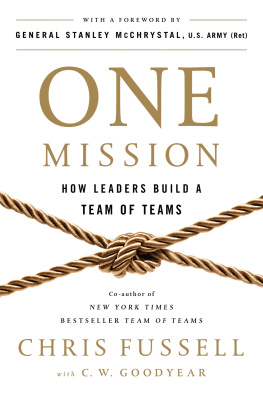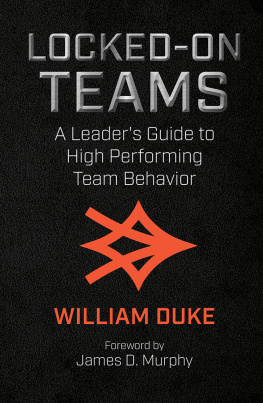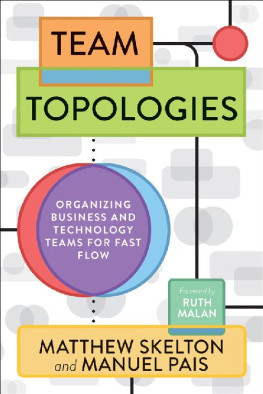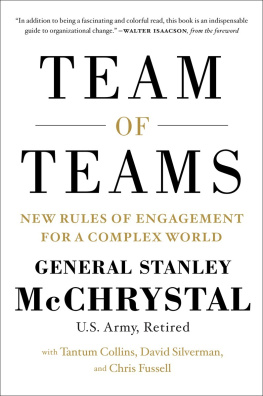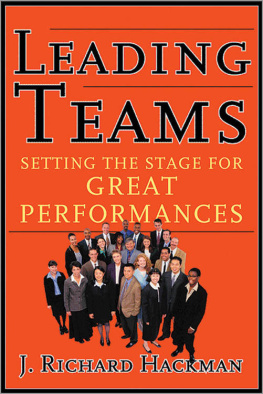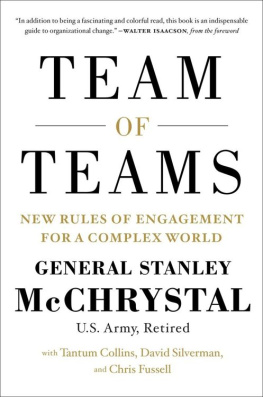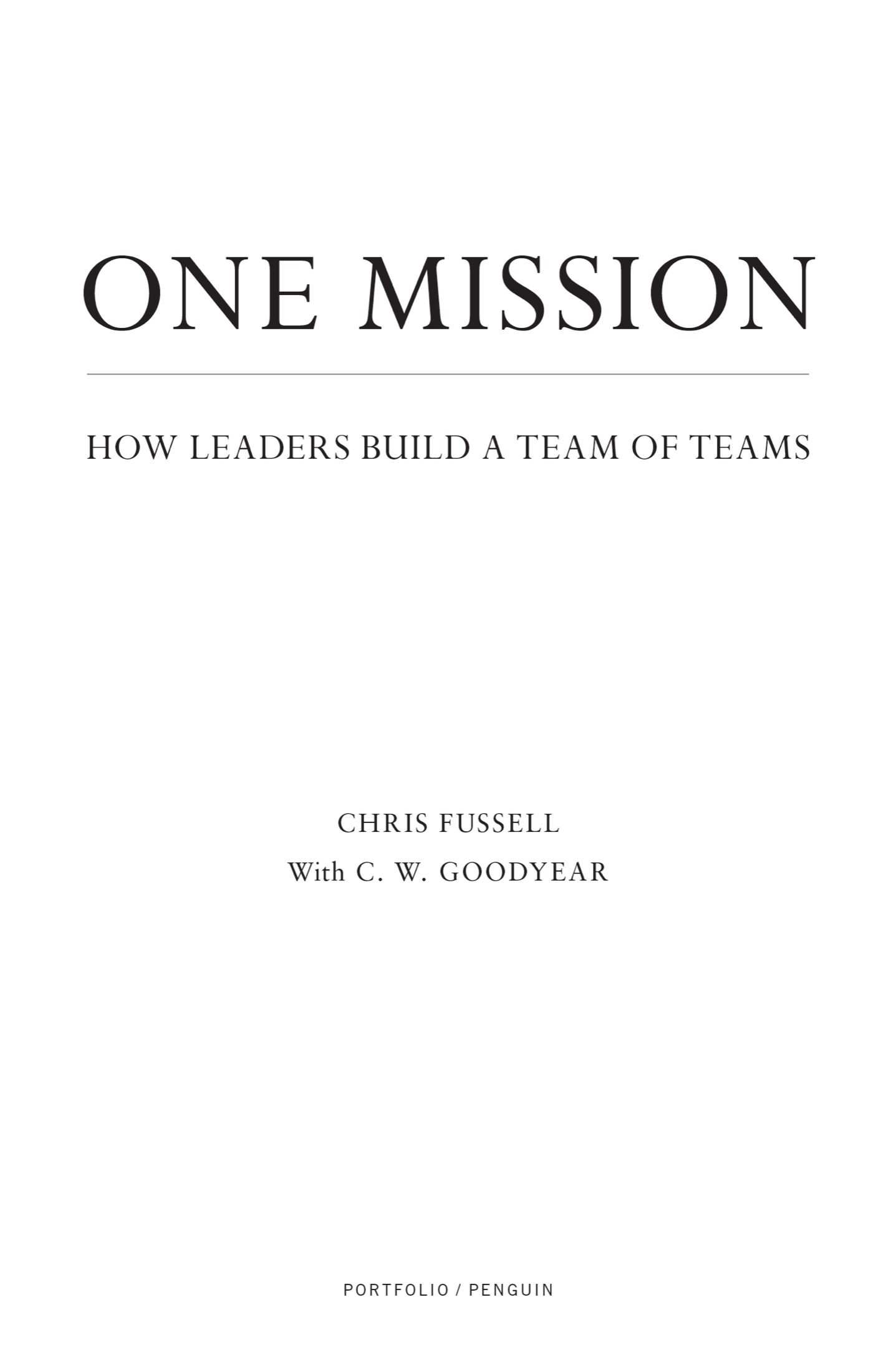Penguin supports copyright. Copyright fuels creativity, encourages diverse voices, promotes free speech, and creates a vibrant culture. Thank you for buying an authorized edition of this book and for complying with copyright laws by not reproducing, scanning, or distributing any part of it in any form without permission. You are supporting writers and allowing Penguin to continue to publish books for every reader.
Images : Intuit Inc.
Names: Fussell, Chris, author. | Goodyear, C. W., author.
Title: One mission : how leaders build a team of teams / Chris Fussell, with C.W. Goodyear.
Identifiers: LCCN 2017013769 (print) | LCCN 2017021010 (ebook) | ISBN 9780735211360 (EPub) | ISBN 9780735211353 (hardcover : alk. paper)
Subjects: LCSH: Teams in the workplace. | Military administrationUnited StatesCase studies. | Organizational effectiveness. | Organizational behavior. | Leadership.
Classification: LCC HD66 (ebook) | LCC HD66 .F87 2017 (print) | DDC 658.4/022dc23
To the men and women, on the battlefield and throughout industry, who are fighting every day to define the future of leadership.
FOREWORD
W e first met in a time of great uncertainty. It was 2004, and our initial expectations of rapid victory in Iraq and Afghanistan had faded into reluctant recognitions that the fight ahead would be long, brutal, and unlike anything wed seen before.
In many ways we were very different. I was a fifty-year-old soldier just completing my first of what would ultimately be almost five years commanding an elite counterterrorist Task Force. Chris Fussell was a Navy SEAL in this organization and was twenty years younger than me. We crossed paths for only an hour at his small teams outpost along the Afghanistan-Pakistan border, but even in this brief initial encounter I recognized a reflective nature that struck me.
We would meet again, less than a year later, in Iraq. Chris had moved up in the organization and was serving as an operations officer at one of the three regional headquarters our Task Force had in the country. In this context he was responsible for reallocating resources, staying attuned to operations, and sharing intelligence. In such a managerial role it was natural, and almost expected, to become ruled by the tyranny of the here and now. Chris was certainly masterful in his conduct of the current fight, but it was his uncommon curiosity about the larger how behind it all that stood out to me.
Chriss constant questioning revealed a unique interest in the design and experimentation taking place at the Task Forces strategic level. For example, he wanted to know how we managed the decentralized decision making that he and his peers had become accustomed to; how we maintained awareness of, but did not impede, the resourcing decisions taking place at the small unit level; and where I saw the broadest gulfs in information sharing between our organization and outside partners. His queries were informed, but in the context of the overwhelming tasks of the daily fight he was orchestrating, to find the time and willpower even to ask them was notable.
Chris was therefore a natural selection to be the aide-de-camp for my final year in command. If he truly wanted to see behind the organizations strategic curtain, a year at my side in Iraq would be a grand opportunity to round out his learning. His primary assigned duty was to manage the logistics of the Task Forces senior leadership team, and ensure that we were spending our time in accordance with the organizations priorities around the world. In addition, I advised him at the outset to exploit this opportunityto actively learn how it all actually worked.
And that is what he did. For a year Chris took it all in, observing the nuances of our organizations process and structure with keen interest. He then went on to graduate school and, still not satisfied, wrote a masters thesis on how our Task Force had organized our intelligence fusion centers around the globe to identify and capture best practices throughout our teams.
So perhaps it was inevitable that over time Chris and I found ourselves connected after the war by a shared fascinationalmost a fixationon the disorienting new phenomenon of complexity that wed faced on the battlefield, and could see across almost every facet of life now that wed left the service.
In the autumn of 2010, six years after wed first met, Chris and I sat at my kitchen table and talked about how the special operations community had made such a significant organizational leap in the post-9/11 years.
If this doesnt get captured in a book, history will get it wrong, he said. By it Chris meant how our Task Force had adapted to an insurgency in Iraq that was a technologically enabled, interconnected network of highly autonomous individual actors. More akin to mobs or violent gangs than a traditional understanding of insurgency would have led us to believe, its membership was motivated by an extremist ideology to foster unconstrained violence wherever possible. To combat the speed and effectiveness of this type of adversary, wed shifted, reluctantly, from a masterfully constructed, purpose-built, centralized structure to a decentralized but deeply interconnected entity whose distributed teams could move with the fluidity of a network while retaining the focus and stability of a bureaucracy.
At the time of that conversation, I was just beginning to write my memoirs, which would consume my efforts for the next two years. But underlying that biographical work was an alternate story, the one that I most wanted to tell, and in the spring of 2013, we told it via the writing project that Chris had first suggested: Team of Teams: New Rules of Engagement for a Complex World, which would be released in the spring of 2015, reflecting years of thought and extensive research on the topic wed first considered at my bland kitchen table.
Team of Teams met our intent to lay out a case about environmental change in modern competitive realms, and deeply resonated with leaders across a wide spectrum of organizations. The consistent You described my organizations problem type of feedback we received reinforced our conclusions that the challenge the Task Force had encountered was not unique to combat but rather reflected the common conditions of our era.
The hierarchical organizational models and leadership norms that we all grew up in were designed for a different type of environment from what were now all facing. Organizations must adapt to the realities of the information age or face existential risk. Our team of teams approach, with its emphasis on shared consciousness and empowered execution, was an important framing and gave language to this universal threat.
Though we didnt call it such at the time of the Iraq war, a team of teams is an operating framework for an organization that weve seen work on the battlefield and in industry. It is grounded in the creation of true strategic alignment across an organization; executing disciplined, broad, and transparent communications; and decentralizing decision making to the edge of the enterprise. It allows traditional organizations to retain the strength of their bureaucracy while moving with the speed of a network.

